Coupling and Coordinated Development of Carbon Emission Efficiency in Industrial Enterprises and the Digital Economy: Empirical Evidence from Anhui, China
Abstract
:1. Introduction
- Industrial enterprises’ carbon emission system and digital economy system can be seen as two complex systems that involve multidimensional indicators, multisource factors, and multiple units of measure. Hence, there is an urgent need for precise measurement and assessment of both industrial enterprises’ carbon emission efficiency and the digital economy, as this is crucial for fostering their coordinated development.
- Many factors influence the coordinated development of the two systems. Scientifically conducting data processing and model development is paramount for formulating targeted strategies that can enhance industrial enterprises’ carbon emission efficiency and facilitate the growth of the digital economy.
- Given the variations in regional resource endowments, as well as the differing levels of industrial enterprises’ and digital economy’s development, it is imperative to devise tailored policies and countermeasures for carbon emission reduction and the digital economy growth, taking into account local specificities.
2. Materials and Methods
2.1. Research Framework
2.2. Index System
2.3. Data Collection and Processing
2.4. Calculating Carbon-Emission Intensity
2.5. Calculating Index Weights of the Digital Economy System
3. Data Modeling
3.1. Calculation Model for Carbon-Emission Efficiency
3.2. Development-Level Measuring Model
3.3. Model of Coupling Degree and Coupling-Coordination Degree
3.4. Data Application
4. Results
4.1. Study Case Introduction
4.2. Analyzing Carbon-Emission Efficiency
4.3. Assessment and Analysis of the Digital-Economy Development-Level Measurement Outcomes
4.4. Analysis of Coupling Coordination between Carbon Emission Efficiency and the Digital Economy
5. Discussion
6. Suggestions
6.1. Suggestions on Coupling and Coordinated Low-Carbon Development of Industrial Enterprises and the Digital Economy for Anhui, China
6.1.1. Enhance Industrial Enterprises’ Carbon Emission Efficiency and Boost the Comprehensive Development of the Digital Economy
6.1.2. Intensify Efforts to Accelerate the Digital Economy’s Growth, with a Particular Focus on Industrial Digitization
6.1.3. Promote Coupling and Coordinated Development of Industrial Enterprises’ Carbon Emission Efficiency and the Digital Economy
6.2. Suggestions on Coupling and Coordinated Low-Carbon Development of Industrial Enterprises and the Digital Economy for Countries or Regions
7. Conclusions
Author Contributions
Funding
Institutional Review Board Statement
Informed Consent Statement
Data Availability Statement
Conflicts of Interest
References
- Cheng, Z.; Li, L.; Liu, J.; Zhang, H. Total-factor carbon emission efficiency of China’s provincial industrial sector and its dynamic evolution. Renew. Sustain. Energy Rev. 2018, 94, 330–339. [Google Scholar] [CrossRef]
- Qin, D.H. Climate change science and sustainable development. Prog. Geogr. 2014, 33, 874. [Google Scholar]
- Zhang, R.; Hanaoka, T. Deployment of electric vehicles in China to meet the carbon neutral target by 2060: Provincial disparities in energy systems, CO2 emissions, and cost effectiveness. Resour. Conserv. Recycl. 2021, 170, 105622. [Google Scholar] [CrossRef]
- Shi, X.; Zheng, Y.; Lei, Y.; Xue, W.; Yan, G.; Liu, X.; Cai, B.; Tong, D.; Wang, J. Air quality benefits of achieving carbon neutrality in China. Sci. Total Environ. 2021, 795, 148784. [Google Scholar] [CrossRef] [PubMed]
- Chen, J.; Lian, X.; Su, H.; Zhang, Z.; Ma, X.; Chang, B. Analysis of China’s carbon emission driving factors based on the perspective of eight major economic regions. Environ. Sci. Pollut. Res. 2020, 28, 8181. [Google Scholar] [CrossRef] [PubMed]
- Zhang, S.J.; Zhang, X.P.; Ge, W.; Shi, C.Y. Carbon neutral transformative technologies for industrial process. Bull. Chin. Acad. Sci. 2022, 37, 511. [Google Scholar]
- Acemoglu, D. Directed technical change. Rev. Econ. Stud. 2002, 69, 781–809. [Google Scholar] [CrossRef]
- Cao, W.; Zhao, W.; Si, Y.J. Impact of digital economy on low-carbon development: Moderating effect and threshold effect of green technology innovation. Soft Sci. 2023, 37, 47. [Google Scholar]
- Li, N.B. Has the digital economy effectively empowered the urban low-carbon development?—Explanation from the progress of low-carbon technology. J. Northeast Norm. Univ. (Philos. Soc. Sci.) 2023, 6, 71. [Google Scholar]
- Chen, J.D.; Wang, J.J. Industrial digitization, local market size and technological innovation. Mod. Econ. Res. 2021, 4, 97–107. [Google Scholar]
- Wu, C.X.; Gao, Y. Research on the mechanism and effect of digital economy driving the development of low-carbon industry. Guizhou Soc. Sci. 2020, 11, 155–161. [Google Scholar]
- Wei, L. Developing the digital economy to accelerate constructing a new development pattern—Reflections based on Marxist political economy. Seek. Truth 2020, 47, 1–9. [Google Scholar]
- Li, Z.; Wang, J. The dynamic impact of digital economy on carbon emission reduction: Evidence city-level empirical data in China. J. Cleaner Prod. 2022, 351, 131570. [Google Scholar] [CrossRef]
- Wang, X.; Zhong, M. Can digital economy reduce carbon emission intensity? Empirical evidence from China’s smart city pilot policies. Environ. Sci. Pollut. Res. Int. 2023, 30, 51749–51769. [Google Scholar] [CrossRef] [PubMed]
- Carlos, G.; Denis, H.; Sven, S.; Zoheir, S.; Conor, D.; Jasmin, P.; Thomas, U.; Paolo, M.; Kathairina, S.; Mike, K.; et al. Future internet technologies for environmental applications. Environ. Modell. Softw. 2016, 78, 1–15. [Google Scholar]
- Thorsten, K.; Josef, W. Seeing through the network: Competitive advantage in the digital economy. J. Organ. Des. 2017, 6, 6. [Google Scholar]
- Li, Y.; Yang, X.; Ran, Q.; Wu, H.; Irfan, M.; Ahmad, M. Energy structure, digital economy, and carbon emissions: Evidence from China. Environ. Sci. Pollut. Res. Int. 2021, 28, 64606–64629. [Google Scholar] [CrossRef] [PubMed]
- Li, W.W.; Wang, W.P.; Wang, Y.; Qin, Y. Industrial structure, technological progress and CO2 emissions in China: Analysis based on the STIRPAT framework. Nat. Hazards 2017, 88, 1545–1564. [Google Scholar] [CrossRef]
- Eddy, D.R.; Georg, S.; Hans, J.P.; Bruno, F. A review of the past, present and future of the European loss prevention and safety promotion in the process industries. Process Saf. Environ. Prot. 2014, 92, 280. [Google Scholar]
- Yang, Y.; Cai, W.J.; Wang, C. Industrial CO2 intensity, indigenous innovation and R&D spillovers in China’s provinces. Appl. Energy 2014, 131, 117. [Google Scholar]
- Cheng, S.; Qu, G. Research on the effect of digital economy on carbon emissions under the background of “double carbon”. Int. J. Environ. Res. Public Health 2023, 20, 4931. [Google Scholar] [CrossRef] [PubMed]
- Wang, H.; Li, Y.; Lin, W.; Wei, W. How does digital technology promote carbon emission reduction? Empirical evidence based on e-commerce pilot city policy in China. J. Environ. Manage. 2023, 325, 116524. [Google Scholar] [CrossRef] [PubMed]
- Mita, B.; Shuddhasattwa, R.; Sankar, B. The role of technology on the dynamics of coal consumption-economic growth: New evidence from China. Appl. Energy 2015, 154, 686–695. [Google Scholar]
- Yang, B. Analysis of the impact mechanism of sustainable development of live e-commerce on the transformation and upgrading of manufacturing industry. J. Commer. Econ. 2021, 12, 172–175. [Google Scholar]
- Heinrichs, H. Sharing Economy: A Potential New Pathway to Sustainability. GAIA—Ecol. Perspect. Sci. Soc. 2013, 22, 228–231. [Google Scholar] [CrossRef]
- Demailly, D.; Novel, A.S. The Sharing Economy: Make It Sustainable; IDDRI: Paris, France, 2014. [Google Scholar]
- Dai, Y.; Wang, X.; Tong, X. From the Sharing Economy to the low-carbon economy—Evidence from bike-sharing platforms. J. Quant. Technol. Econ. 2024, 41, 111–130. [Google Scholar]
- Momo. The State of European Car Sharing. Final Report D2.4 Work Package 2; momo Car-Sharing: Skopje, North Macedonia, 2010. [Google Scholar]
- Liu, X.L.; Xiong, X. Dynamic comparison of the decoupling relationship between industrial enterprises’ benefits and carbon emissions: Based on the data of ABS smelting company since the 11th five-year Plan. Public Fin. Res. 2015, 3, 16. [Google Scholar]
- Wang, Q.; GE, Y.; Li, R. Evolution and driving factors of ocean carbon emission efficiency: A novel perspective on regional differences. Mar. Pollut. Bull. 2023, 194, 115219. [Google Scholar] [CrossRef]
- Begum, R.A.; Sohag, K.; Abdullah, S.M.S.; Jaafar, M. CO2 emissions, energy consumption, economic and population growth in Malaysia. Renew. Sustain. Energy Rev. 2015, 41, 594–601. [Google Scholar] [CrossRef]
- Xie, Y.F. The effect and mechanism of digital economy on regional carbon emission intensity. Contemp. Econ. Manage. 2022, 44, 68. [Google Scholar]
- Mu, L.J.; Chen, J.; Fan, T.Z.; Lyv, Y.Q. The impact of digital economy development on carbon emissions—Based on panel data analysis of 278 prefecture-level cities. S. China Fin. 2022, 2, 45. [Google Scholar]
- Han, D.; Ding, Y.; Shi, Z.; He, Y. The impact of digital economy on total factor carbon productivity: The threshold effect of technology accumulation. Environ. Sci. Pollut. Res. Int. 2022, 29, 55691–55706. [Google Scholar] [CrossRef] [PubMed]
- Ma, T.; Cao, X. The effect of the industrial structure and haze pollution: Spatial evidence for China. Environ. Sci. Pollut. Res. Int. 2022, 29, 23578–23594. [Google Scholar] [CrossRef] [PubMed]
- Zhang, L.; Mu, R.; Zhan, Y.; Yu, J.; Liu, L.; Yu, Y.; Zhang, J. Digital economy, energy efficiency, and carbon emissions: Evidence from provincial panel data in China. Sci. Total Environ. 2022, 852, 158403. [Google Scholar] [CrossRef]
- Xu, Q.; Zhong, M.; Cao, M. Does digital investment affect carbon efficiency? Spatial effect and mechanism discussion. Sci. Total Environ. 2022, 827, 154321. [Google Scholar] [CrossRef] [PubMed]
- Cheng, C.; Ren, X.; Dong, K.; Dong, X.; Wang, Z. How does Technological innovation mitigate CO2 emissions in OECD countries? Heterogeneous analysis using panel quantile regression. J. Environ. Manag. 2021, 280, 111818. [Google Scholar] [CrossRef] [PubMed]
- Guo, A.J.; Zhang, C.B. How does the digital economy affect the intensity of carbon emissions—Based on the dual perspectives of industrial structure upgrading and rationalization. Sci. Sci. Manag. S. T 2023, 11, 1. [Google Scholar]
- Ge, L.Y.; Mo, L.J.; Huang, N.B. Development of digital economy, upgrading of industrial structure and urban carbon emission. Mod. Fin. Econ. J. Tianjin Univ. Fin. Econ. 2022, 42, 20. [Google Scholar]
- Jin, F.; Xu, C.L. Study on the nonlinear influence of digital economy development on carbon emission. Mod. Econ. Res. 2022, 11, 14–23. [Google Scholar]
- Xie, N.Y.; Zhang, Y. The impact of digital economy on industrial carbon emission efficiency: Evidence from Chinese provincial data. Math. Probl. Eng. 2022, 2022, 6583809. [Google Scholar] [CrossRef]
- Ford, S.; Despeisse, M. Additive manufacturing and sustainability: An exploratory study of the advantages and challenges. J. Cleaner Prod. 2016, 137, 1573–1587. [Google Scholar] [CrossRef]
- Liu, L.; Zhang, Y.; Gong, X.; Li, M.Y.; Li, X.; Ren, D.; Jiang, P. Impact of digital economy development on carbon emission efficiency: A spatial econometric analysis based on Chinese provinces and cities. Int. J. Environ. Res. Public Health 2022, 19, 14838. [Google Scholar] [CrossRef] [PubMed]
- Sorrell, S. Energy, economic growth and environmental sustainability: Five propositions. Sustainability 2010, 2, 1784. [Google Scholar] [CrossRef]
- Ishida, H. The effect of ICT development on economic growth and energy consumption in Japan. Telemat. Inform. 2015, 32, 79–88. [Google Scholar] [CrossRef]
- Jia, B.; Liu, H. Study on the decoupling of carbon emissions from energy consumption and economic development in Yunnan Province. Jiangsu Comm. Forum 2016, 12, 18–21. [Google Scholar]
- Tian, X.; Chang, M.; Shi, F.; Tanikawa, H. How does industrial structure change impact carbon dioxide emissions? A comparative analysis focusing on nine provincial regions in China. Environ. Sci. Policy 2014, 37, 243–254. [Google Scholar] [CrossRef]
- Wang, L.; Chen, L.; Li, Y. Digital economy and urban low-carbon sustainable development: The role of innovation factor mobility in China. Environ. Sci. Pollut. Res. 2022, 29, 48539–48557. [Google Scholar] [CrossRef] [PubMed]
- Soumyananda, D. A theoretical basis for the environmental Kuznetscurve. Ecol. Econ. 2004, 53, 403. [Google Scholar]
- Pan, W.; Tu, H.; Hu, C.; Pan, W. Driving forces of China’s multisector CO2 emissions: A log-mean divisia index decomposition. Environ. Sci. Pollut. Res. Int. 2020, 27, 23550–23564. [Google Scholar] [CrossRef]
- Lin, X.Q.; Tong, X. Analysis of provincial differences in industrial carbon emissions based on Theil index-A case study of five pilot provinces. Sci. Technol. Econ. 2016, 29, 106. [Google Scholar]
- Zhang, W.; Liu, X.; Wang, D.; Zhou, J. Digital economy and carbon emission performance: Evidence at China’s city level. Energy Policy 2022, 165, 112927. [Google Scholar] [CrossRef]
- Lin, B.; Du, C. The impact of factor market distortions on energy efficiency. Econ. Res. J. 2013, 48, 125. [Google Scholar]
- Pang, W.; Ma, Y.; Tang, Z. Study on the coupling relationship and coordinated development between tourism economy and ecological environment: A case study of Xi’an City. J. Northwest. Univ. (Nat. Sci. Ed.) 2011, 41, 1097. [Google Scholar]
- Bai, L.; Chen, H.; Gao, Q.; Luo, W. Project portfolio selection based on synergy degree of composite system. Soft Comput. 2018, 22, 5535–5545. [Google Scholar] [CrossRef]
- Zeng, Q.L.; Sun, Q.B. An empirical study on the coupling relationship between modern agriculture and logistics industry in China. Stat. Decis. 2016, 8, 94–97. [Google Scholar]
- Shi, T.; Yang, S.; Zhang, W.; Zhou, Q. Coupling coordination degree measurement and spatiotemporal heterogeneity between economic development and ecological environment: Empirical evidence from tropical and subtropical regions of China. J. Clean. Prod. 2020, 244, 118739. [Google Scholar] [CrossRef]
- Zhang, Z.; Xue, Q. Low-carbon economy, industrial structure and changes in China’s development mode based on the data of 1996-2009 in empirical analysis. Energy Procedia 2011, 5, 2025–2029. [Google Scholar]
- Xu, Z.; Ci, F. Spatial-temporal characteristics and driving factors of coupling coordination between the digital economy and low-carbon development in the Yellow River Basin. Sustainability 2023, 15, 2731. [Google Scholar] [CrossRef]
- Wu, C. The impact of urbanization on agricultural carbon emissions in China: An empirical study of inter-provincial data. Econ. Surv. 2015, 32, 12. [Google Scholar]
- Jiang, J.; Zhu, S.; Wang, W.; Li, Y.; Li, N. Coupling coordination between new urbanisation and carbon emissions in China. Sci. Total Environ. 2022, 850, 158076. [Google Scholar] [CrossRef]
- Chen, Y. Financial support for China’s new-type urbanization. Econ. Res. J. 2013, 48, 10. [Google Scholar]
- Xiong, X.; Xu, Z. Research on the influence of financial support in the process of new urbanization in China. J. Quant. Technol. Econ. 2015, 32, 73. [Google Scholar]
- Yao, F.; Xue, L.; Liang, J. Research on coupling coordination and influencing factors between urban low-carbon economy efficiency and digital finance: Evidence from 100 cities in China’s Yangtze River economic belt. PLoS ONE 2022, 17, e0271455. [Google Scholar] [CrossRef] [PubMed]
- Song, Y.; Hu, H.; Song, G. Empirical study on the relationship between agricultural technical efficiency improvement and urbanization: A case study of six provinces in central and western China. Stat. Inf. 2012, 27, 53. [Google Scholar]
- Wang, F.; Mao, A.; Li, H. Measurement and spatial difference analysis of urbanization quality in Shandong Province based on entropy method. Sci. Geogr. Sin. 2013, 33, 1323. [Google Scholar]
- Cai, J.; Li, X.; Liu, L.; Chen, Y.; Wang, X.; Lu, S. Coupling and coordinated development of new urbanization and agro-ecological environment in China. Sci. Total Environ. 2021, 776, 145837. [Google Scholar] [CrossRef] [PubMed]
- Guo, Y.; Ding, H. Coupled and coordinated development of the data-driven logistics industry and digital economy: A case study of Anhui Province. Processes 2022, 10, 2036. [Google Scholar] [CrossRef]
- Liu, C.; Wang, X.; Bai, Z.; Wang, H.; Li, C. Does digital technology application promote carbon emission efficiency in dairy farms? Evidence from China. Agriculture 2023, 13, 904. [Google Scholar] [CrossRef]
- Liu, W.; Wang, Y. Effect and mechanism of digital economy empowering urban green and high-quality development. S. China J. Econ. 2022, 8, 73–91. [Google Scholar]
- Liao, X.; Yang, Z. Effect measurement and realization path of transformation and upgrading of digital economy enabling manufacturing industry in the Yangtze River Delta. East China Econ. Manag. 2021, 35, 22. [Google Scholar]
- Wei, L.; Hou, Y. Research on the impact of China’s digital economy on urban green development. J. Quant. Technol. Econ. 2022, 39, 60. [Google Scholar]
- Guo, Y.; Mao, H.; Ding, H.; Wu, X.; Liu, Y.; Liu, H.; Zhou, S. Data-driven coordinated development of the digital economy and logistics industry. Sustainability 2022, 14, 8963. [Google Scholar] [CrossRef]
- Luo, D.; Liang, L.; Wang, Z.; Chen, L.; Zhang, F. Exploration of coupling effects in the economy-society-environment system in urban areas: Case study of the Yangtze River Delta urban agglomeration. Ecol. Indic. 2021, 128, 107858. [Google Scholar]
- Xu, M.; Hu, W.Q. A research on coordination between economy, society and environment in China: A case study of Jiangsu. J. Clean. Prod. 2020, 258, 120641. [Google Scholar] [CrossRef]
- Jiang, Y.; Lan, T.; Wu, L. A comparison study of missing value processing methods in time series data mining. In Proceedings of the International Conference on Computational Intelligence & Software Engineering, Wuhan, China, 11–13 December 2009; Volume 1. [Google Scholar]
- IPCC. Global Warming of 1.5 °C. An IPCC Special Report on the Impacts of Global Warming of 1.5 °C above Pre-industrial Levels and Related Global Greenhouse Gas Emission Pathways, in the Context of Strengthening the Global Response to the Threat of Climate Change, Sustainable Development, and Efforts to Eradicate Poverty. 2018. Available online: https://www.ipcc.ch/sr15/ (accessed on 28 March 2024).
- Cuiju, Z.; Zongyi, Z. Agglomeration effect and radiation effect of carbon emission intensity at provincial level in China. Acta Sci. Circum. 2017, 37, 1178. [Google Scholar]
- International Panel on Climate Change (IPCC). IPCC Guidelines for National Greenhouse Gas Inventories; IPCC/IGES: Hayama, Japan, 2006. [Google Scholar]
- Ren, F.; Yu, X. Coupling analysis of urbanization and ecological total factor energy efficiency: A case study from Hebei Province in China. Sustain. Cities Soc. 2021, 74, 103183. [Google Scholar] [CrossRef]
- Cai, A.; Zheng, S.; Cai, L.H.; Yang, H.; Comite, U. How does green technology innovation affect carbon emissions? A spatial econometric analysis of China’s provincial panel data. Front. Environ. Sci. Eng. 2021, 9, 813811. [Google Scholar] [CrossRef]
- Pradhan, R.P.; Arvin, M.B.; Nair, M.; Bennett, S.E. Sustainable economic growth in the European Union: The role of ICT, venture capital, and innovation. Rev. Financ. Econ. 2020, 38, 34–62. [Google Scholar] [CrossRef]
- Abbas, Q.; HongXing, Y.; Ramzan, M.; Fatima, S. Carbon reduction through renewable energy and digitalization in emerging economies: Moderating role of public debt. Environ. Sci. Pollut. Res. Int. 2024, 31, 43096–43116. [Google Scholar] [CrossRef]
- Ghezelbash, A.; Liu, J.; Fahimifard, S.H.; Khaligh, V. Exploring the Influence of the Digital Economy on Energy, Economic, and Environmental Resilience: A Multinational Study across Varied Carbon Emission Groups. Sustainability 2024, 16, 2993. [Google Scholar] [CrossRef]
- Yasmeen, R.; Tian, T.; Yan, H.; Shah, W.U.H. A simultaneous impact of digital economy, environment technology, business activity on environment and economic growth in G7: Moderating role of institutions. Heliyon 2024, 10, e32932. [Google Scholar] [CrossRef] [PubMed]
- Fernández, F.Y.; López, F.M.; Blanco, O.B. Innovation for sustainability: The impact of R&D spending on CO2 emissions. J. Clean. Prod. 2018, 172, 3459–3467. [Google Scholar]
- Kunkel, S.; Matthess, M. Digital transformation and environmental sustainability in industry: Putting expectations in Asian and African policies into perspective. Environ. Sci. Policy 2020, 112, 318–329. [Google Scholar] [CrossRef]
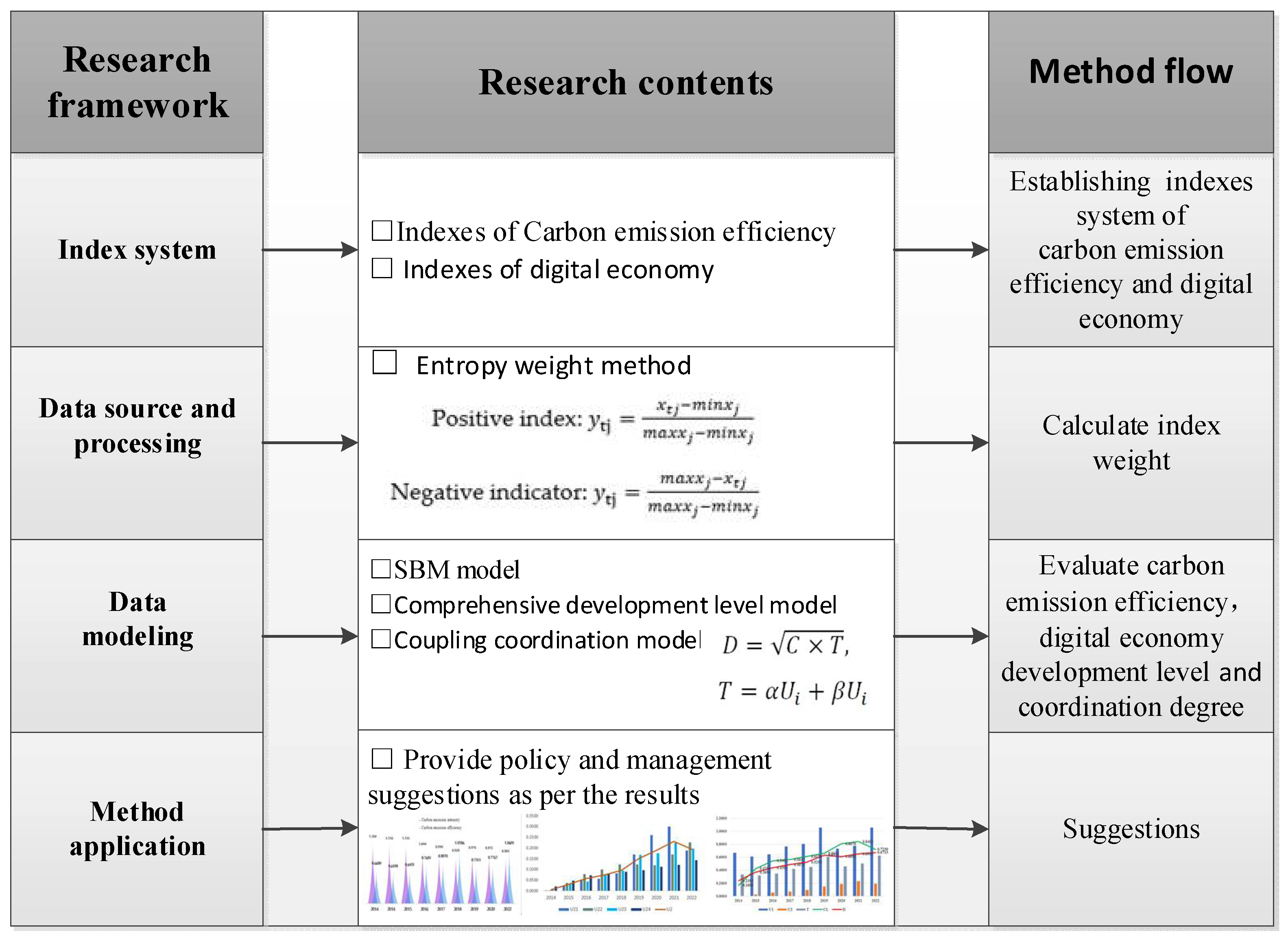
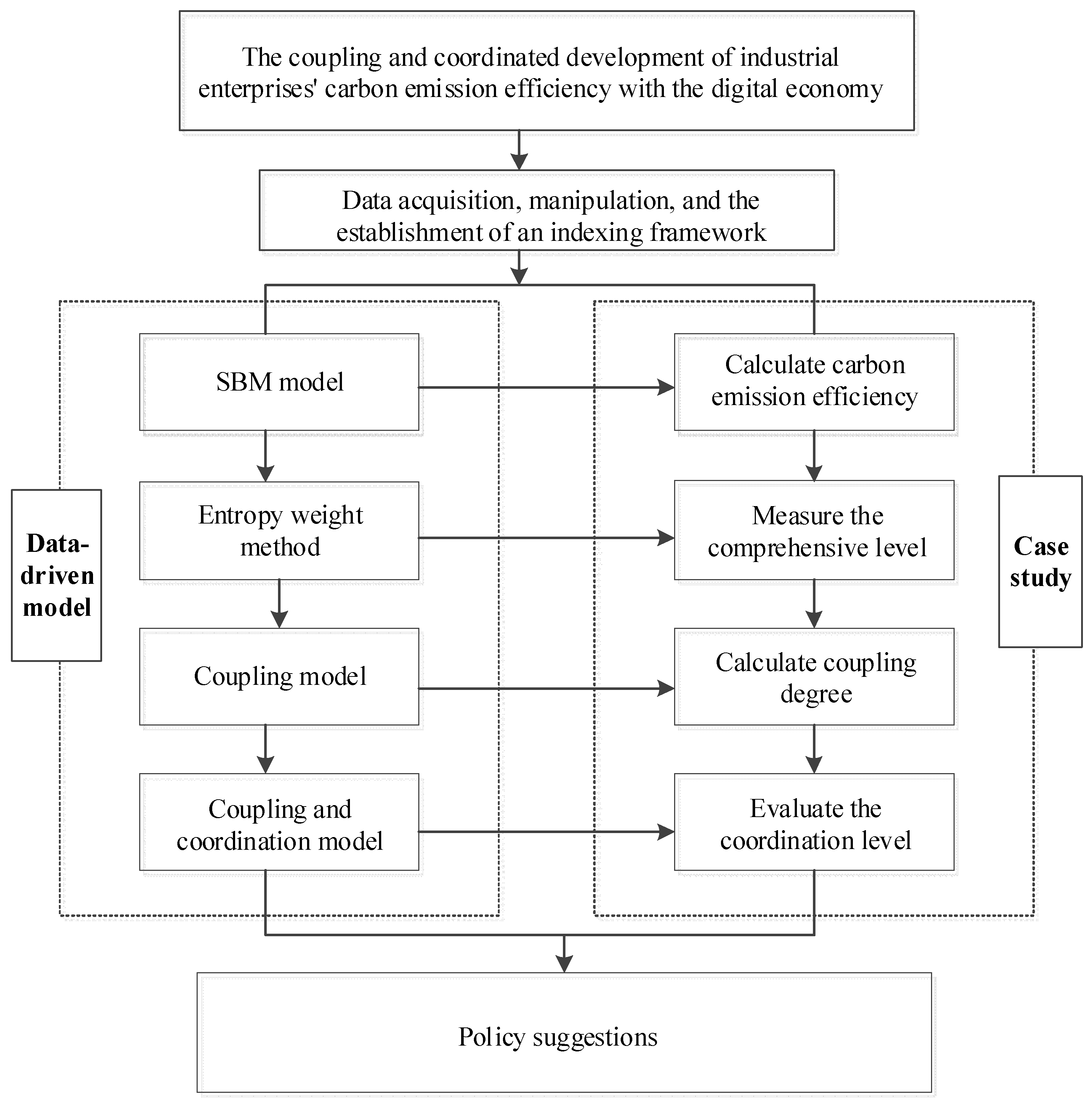
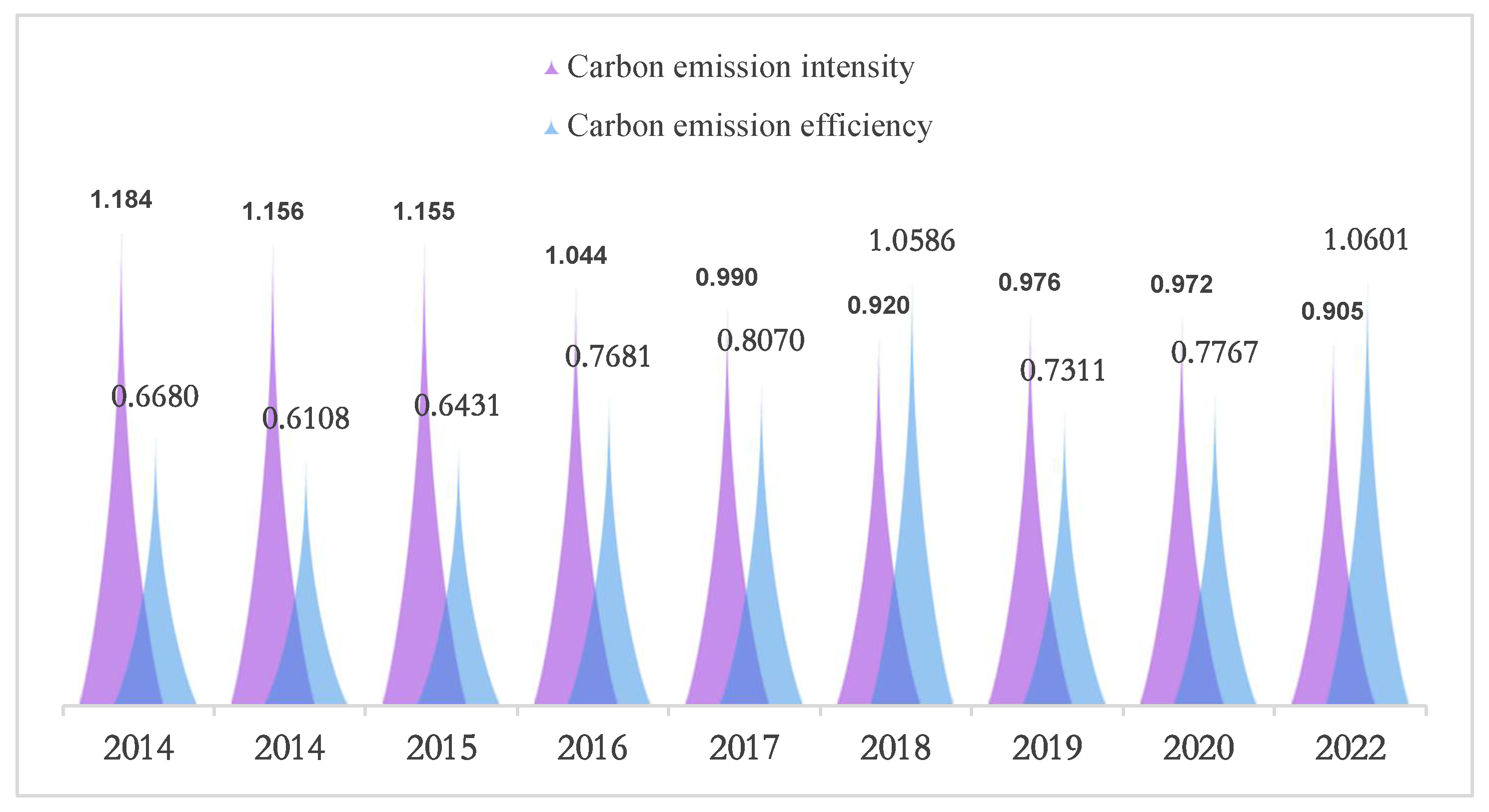
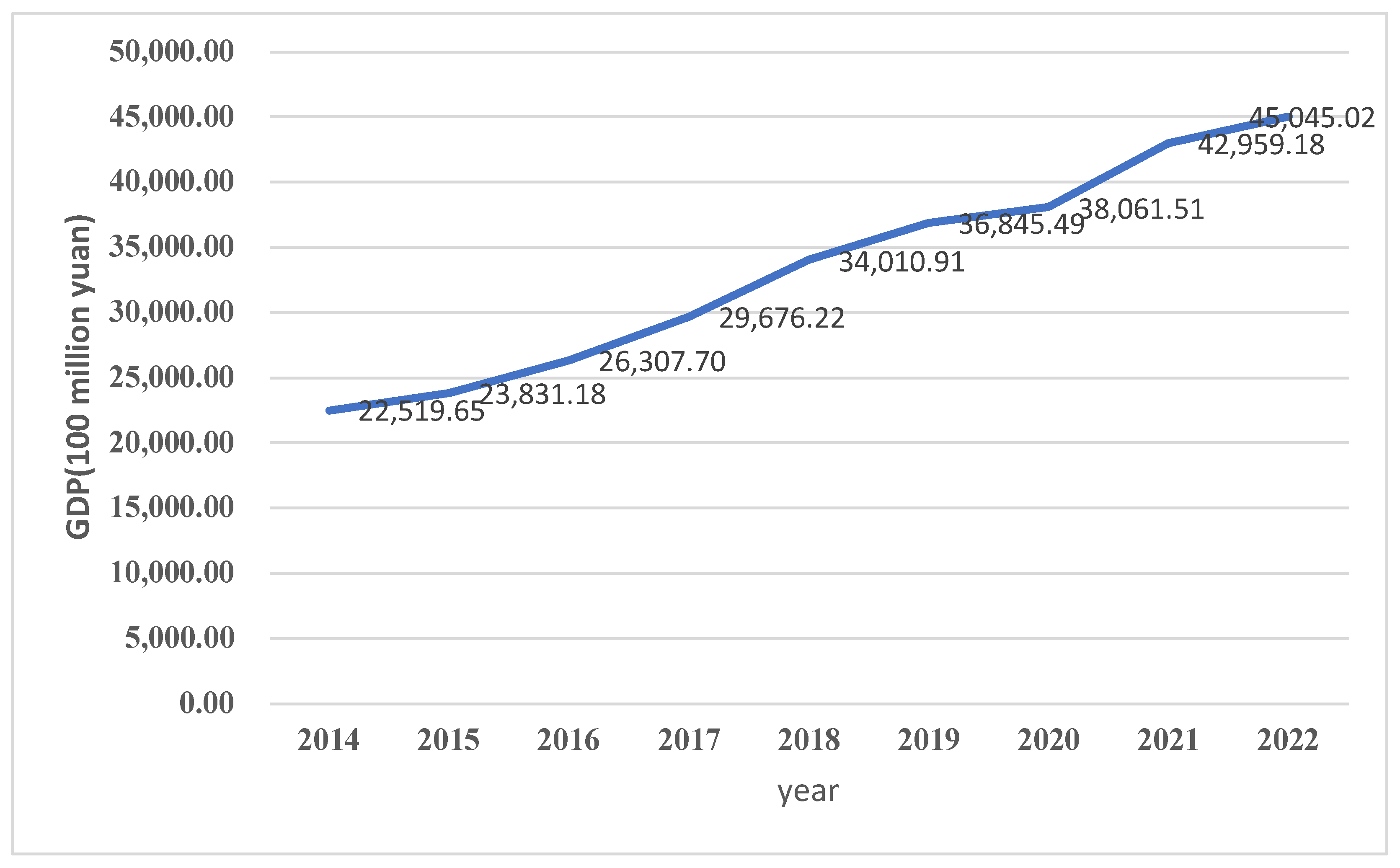

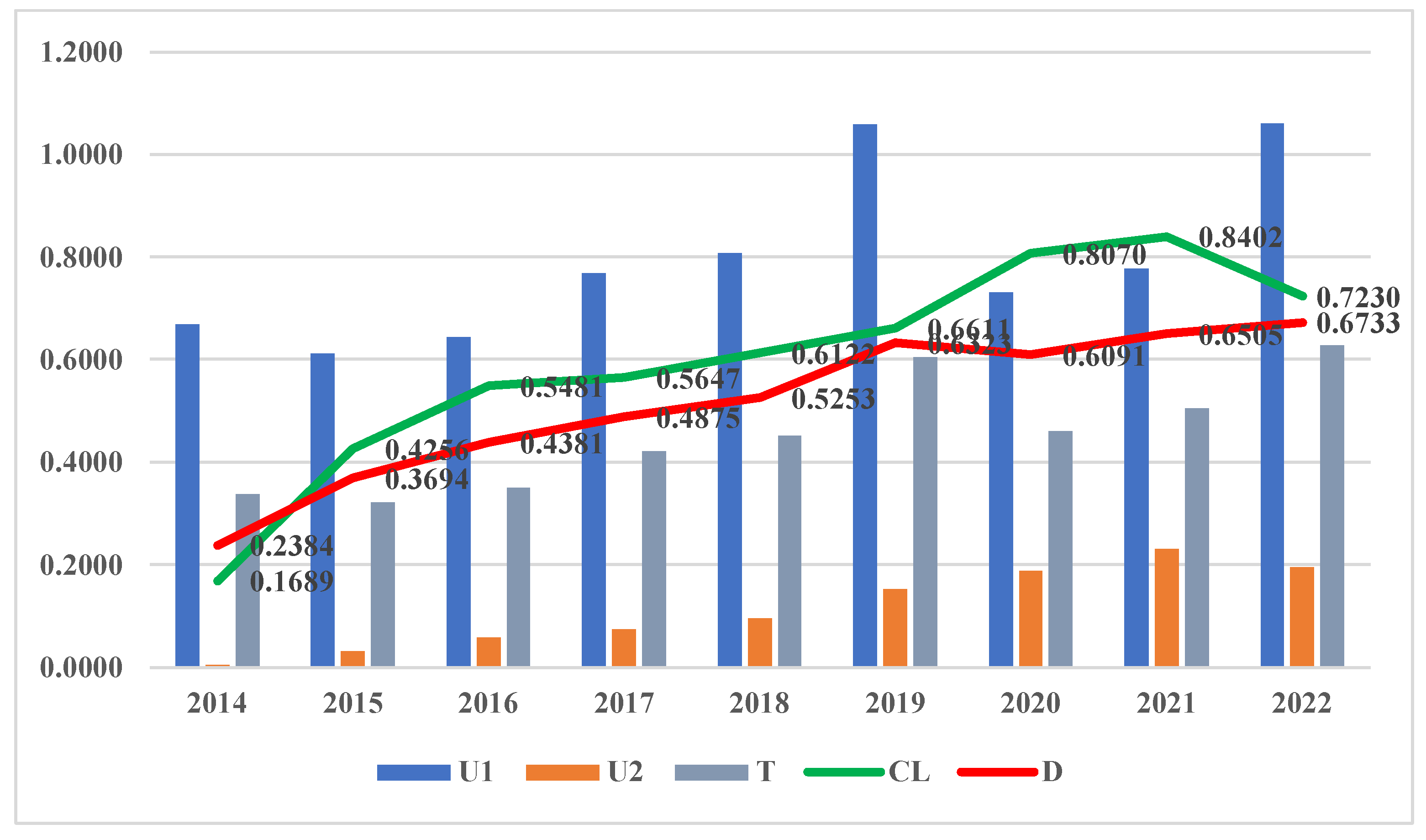
| System | Primary Index | Variables and Interpretation | Code | Positive/ Negative |
|---|---|---|---|---|
| Industrial enterprises’ carbon emission efficiency (U1) | Input (U11) | Average asset investment of industrial enterprises above designated size (CNY 100 million) (Total assets divided by enterprise’s count) | + | |
| Average count of industrial enterprises’ employees (10,000 persons/unit) | + | |||
| Total energy consumption of industrial enterprises above designated size (10,000 tons of standard coal) (Yearly consumption) | − | |||
| Expected output (U12) | Profits of industrial enterprises above designated size (CNY 100 million) (Yearly profit) | + | ||
| Non-expected output (U13) | Carbon emission intensity of industrial enterprises above designated size (10,000 tons/CNY 100 million) (Carbon emissions divided by output value) | − | ||
| Digital economy system (U2) | Digital infrastructure (U21) | Internet penetration (%) (Proportion of Internet users to the total resident population) | + | |
| Total telecommunications business (CNY 100 million) (Total amount of various telecommunication services provided by telecommunication enterprises to the society, expressed in monetary form) | + | |||
| Cell phone penetration rate (units/100 persons) (The proportion of the population using mobile phones) | + | |||
| Domain names per capita (PCs) (Current total number of the statistical year) | + | |||
| Count of per capita web pages (Current total number of the statistical year) | + | |||
| Digital industry (U22) | Percentage of software revenue in GDP (%) (Software revenue divided by GDP) | + | ||
| The proportion of GDP derived from information transmission, software, and information technology services revenue (%) (Revenue divided by GDP) | + | |||
| The proportion of GDP derived from computer communications and other electronic equipment manufacturing revenues (%) (Revenue divided by GDP) | + | |||
| Investment in fixed assets for information services (CNY 100 million) (Annual amount of new investment) | + | |||
| Employment in the information transmission, software, and information technology services sector (10,000 persons) (Total employment in statistical year) | + | |||
| Profit in the computer, communication, and other electronic equipment manufacturing industry (CNY 100 million) (Yearly profit) | + | |||
| Digital technology innovation (U23) | Employees working in the scientific research and technical services sector (10,000 persons) (Total employment in statistical year) | + | ||
| Expenditure on research and experimental development (CNY 100 million) (Yearly expenditure) | + | |||
| Number of qualifications of bachelor’s degree or above (person) (Total number in statistical year) | + | |||
| The count of patent applications (items/10,000 persons) (Annual number of new applications) | + | |||
| The percentage of GDP contributed by the output value of scientific research and technical services (yearly value divided by GDP) | + | |||
| Industrial digitization (U24) | The number of computers for every 100 people (units) (Number of computers divided by the number of people) | + | ||
| The number of websites operated by every 100 companies (Number of pages divided by the number of people) | + | |||
| Sales generated through electronic commerce (CNY 100 million) (Revenue from e-commerce transactions in statistical year) | + | |||
| Number of e-commerce enterprises | + | |||
| E-commerce purchases (CNY 100 million) (The value of purchases made through electronic commerce in the statistical year) | + |
| Fossil Fuel | SCC | CEF |
|---|---|---|
| coal | 0.7143 | 0.7559 |
| coke | 0.9714 | 0.855 |
| crude oil | 1.4286 | 0.5538 |
| gasoline | 1.4714 | 0.5921 |
| diesel | 1.4571 | 0.6185 |
| natural gas | 1.33 | 0.4483 |
| CL | Coupling Phase | Coupling Specification | D | Coordination Level |
|---|---|---|---|---|
| (0.0, 0.3] | Low coupling | Coupling gradually | (0.0, 0.1] | Severely discordant |
| (0.1, 0.2] | Severe discordant | |||
| (0.2, 0.3] | Moderate discordant | |||
| (0.3, 0.6] | Antagonism | Certain degree of development | (0.3, 0.4] | Mild discordant |
| (0.4, 0.5] | Borderline discordant | |||
| (0.5, 0.6] | Barely coordinated | |||
| (0.6, 0.8] | Running-in | Good coupling development | (0.6, 0.7] | Primary coordination |
| (0.7, 0.8] | Intermediate coordination | |||
| (0.8, 1.0] | High coupling | Mutually reinforcing development | (0.8, 0.9] | Well-coordinated |
| (0.9, 1.0] | Highly coordinated |
Disclaimer/Publisher’s Note: The statements, opinions and data contained in all publications are solely those of the individual author(s) and contributor(s) and not of MDPI and/or the editor(s). MDPI and/or the editor(s) disclaim responsibility for any injury to people or property resulting from any ideas, methods, instructions or products referred to in the content. |
© 2024 by the authors. Licensee MDPI, Basel, Switzerland. This article is an open access article distributed under the terms and conditions of the Creative Commons Attribution (CC BY) license (https://creativecommons.org/licenses/by/4.0/).
Share and Cite
Hu, F.; Liu, H.; Guo, Y.; Ding, H.; Wang, K. Coupling and Coordinated Development of Carbon Emission Efficiency in Industrial Enterprises and the Digital Economy: Empirical Evidence from Anhui, China. Sustainability 2024, 16, 6248. https://doi.org/10.3390/su16146248
Hu F, Liu H, Guo Y, Ding H, Wang K. Coupling and Coordinated Development of Carbon Emission Efficiency in Industrial Enterprises and the Digital Economy: Empirical Evidence from Anhui, China. Sustainability. 2024; 16(14):6248. https://doi.org/10.3390/su16146248
Chicago/Turabian StyleHu, Fagang, Hongjun Liu, Yuxia Guo, Heping Ding, and Kun Wang. 2024. "Coupling and Coordinated Development of Carbon Emission Efficiency in Industrial Enterprises and the Digital Economy: Empirical Evidence from Anhui, China" Sustainability 16, no. 14: 6248. https://doi.org/10.3390/su16146248






